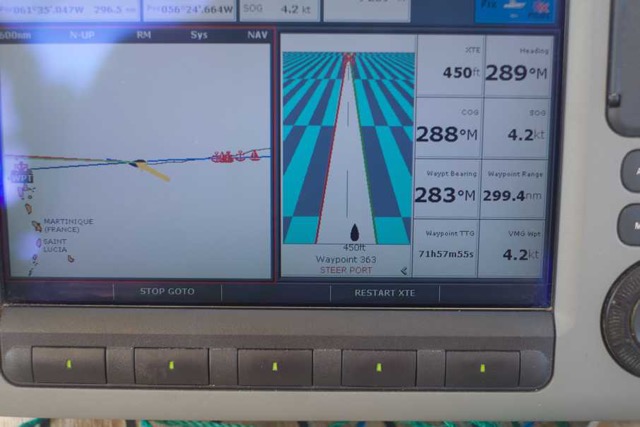Velocity Made Good

Vega
Hugh and Annie
Fri 22 Jan 2016 13:25
17:14.8N 58:25.9W Velocity. Its a wonderful word and one that I have always associated with speed, by which I mean going fast. As in a rocket travelling through space at high velocity, or a high velocity rifle. Which is why I find it a bit incongruous when applied to a yacht (our yacht in particular). When travelling towards a specified point the direct route is likely to be the shortest but there may not be a direct correlation between the speed of the boat, the distance to be travelled and the time it will take. For example, if the boat is travelling at an indicated 5kts but directly into a current of 2kts, the actual speed over the ground is only 3kts which is what is meant by the Velocity Made Good - the actual speed towards your destination. The position becomes more complicated when, for example, the direct route may be affected by a cross current or is not at an angle at which the boat would sail at its fastest. Sometimes you cannot sail the direct route if it is straight into the wind and it is necessary to tack at an angle either side of the direct route. Sometimes you may choose an indirect route if this means that the extra speed more than compensates for the extra distance - which is what catamarans and many racing boats do when the direct route is downwind. Sometimes it can be fairly obvious if there is a net gain in speed by not following the direct route. Sometimes it can be quite complicated to work out the best route given the prevailing wind, tide, current, leeway (sideways drift) and so on. This has never really been an issue for Annie and me because being simple, lazy souls we take a non direct route if either forced to or if the advantage of doing so is readily apparent. However, “readily apparent” may be fools gold and even racing boats may take a chance in the hope that it pays off without being certain that it will work. Steve, who has done a lot of his recent sailing in races and who is now anxious to sail the fastest route to Antigua, is acutely aware of Velocity Made Good (VMG to use the standard abbreviation) and asked how we worked this out, on the naive assumption that we did of course. Now, VMG is a concept likely to be seized upon by the razor sharp, ever inquiring mathematical intellect possessed by someone such as our navigator. In fact she may well have factored this into her calculations as a matter of course - ha ha - thinking it too banal ever to comment upon. What she and I had not thought through, however, is the fact that the boat’s instruments have all the information on the boats speed and direction to be able to tell at any time what the VMG is on any particular course. One of the screen selection choices offered is a split screen view with the chart on one side and something blue on the other that I had assumed was to do with fish finding or something. On closer examination (by actually selecting this choice) it turns out to be a representation of your track (route) which shows much as a straight road on a car sat nav. The plotter will then show you whether you are on the right track or somewhere to one side of it. Deviation from the track is known as Cross Track Error and is something taught in the RYA syllabus because it can be important to maintain an accurate track if navigating a narrow channel or between hazards or whatever. A familiar concept to we Luddites used to paper charts and pencils but otherwise a bit technophobic. Not only does the plotter show XTE (yes even sailing is blighted by our mania for abbreviation) but a lot more besides, including VMG! As it happens, previous lyrical waxing about perfect sailing conditions is no longer appropriate. We are now motoring across the Atlantic and have been all night. So depressing. I was all for lolling around waiting for the wind to return much as our noble ancestors would have done but before I could shout “mutiny” the crew had furled the sails and the motor was revving. I write this from the forward cabin to which I have been confined under lock and key. However, the point is that the most direct route to our destination when motoring across this ocean is right on the track. The navigator has taken a particular interest in this screen now and I am berated every time we stray into a few centimetres of XTE. Fortunately the navigator considers XTE to be more for RYA exams than crossing oceans and this screen may not be an ongoing feature of our navigation. Clever though it is, it does take some of the romance out of the task. This morning’s sunrise below   |